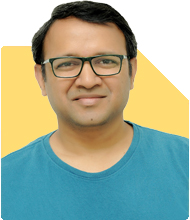Ramalingam Kalirajan |10894 Answers |Ask -Follow
Mutual Funds, Financial Planning Expert - Answered on Jun 25, 2024
He has an MBA in finance from the University of Madras and is a certified financial planner.
He is the director and chief financial planner at Holistic Investment, a Chennai-based firm that offers financial planning and wealth management advice.... more

Hello. I am 41 years old and I am planning to open my own small business of food outlet as I was in same industry in next 3 month after planning of 1.5 years. Currently I have below savings. 4,00,000/- in NPS adding 5,000 each month. 6,00,000/- in PPF adding 5,000 each month. I have below SIP. Franklin India tax shield growth. Investment is 10,70,000/- and gain is 51,21700/- 5000 SIP. HDFC Defense fund regular growth. Investment is 33,000/- and gain is 15,538/- 3000 SIP. HDFC Flexi Cap Fund Direct growth. Investment is 5,48,000/- and gain is 11,70,600/- 4000 SIP. And also invested in below mutual funds as lumpsum. Aditya Birla sunlife Equity Hybrid fund growth. AXIS small cap fund regular growth. HDFC Balanced Advantage Fund direct growth HDFC Midcap opportunities fund regular growth HDFC NIFTY200 momentum index fund growth HDFC small cap fund direct growth HDFC top 100 fund direct growth ICICI Prudential Bluechip Fund Growth Motilal Oswal large and mid cap fund growth Motilal Oswal small cap fund regular growth Nippon India multi cap fund retail plan growth Nippon India small cap fund growth Quant small cap fund regular growth SBI contra fund growth UTI MNC fund growth. Total Investment is 21,50,000/- and gain is 16,70,000/- which was reinvested by tax-harvesting in same mutual funds. Since my age of 25 I have started investing 10,000/- in NSC. And after maturing after 5 years add 15,000/- and make it round figure value in and then some same thing in my years of 35 to 40 years. Investing 25,000/- and made round five and invested in NSC. I get maturity of NSC on 1st of every month now. I have 25,00,000 as emergency fund kept in FDs in bank. And I have also invested if Rs. 12,00,000 in shares from which gain is of 6,00,000/- Investment in physical gold is 3,50,000/- from which gain is 35,00,000/- Investment in physical silver is 75,000/- from which gain is 3,50,000/- ULIP investment is 1,50,000/- and gain is 2,70,000/- My monthly income is the income which I receive from FDs and NSC maturation which I reinvest now. My expenses exceeds no more than 65,000/- which includes SIP investment and PPF and NPS investments. I have my own home which costs 98,00,000/- and 18 years of EMIs are pending which my wife is paying pending amount as we divide everything in home. I have 7 years old son who is studying in school. I want suggestion that can I retire now or should I start getting along with small business. As if I stay back home it will be very hard for me coz previously I used to work for more than 12 to 14 hours daily. Also do let me know if I need to change anything in my investment.
Current Financial Snapshot
Savings and Investments
NPS: Rs 4,00,000, adding Rs 5,000 monthly.
PPF: Rs 6,00,000, adding Rs 5,000 monthly.
Mutual Funds SIPs:
Franklin India Tax Shield Growth: Investment Rs 10,70,000, gain Rs 51,21,700, SIP Rs 5,000.
HDFC Defense Fund Regular Growth: Investment Rs 33,000, gain Rs 15,538, SIP Rs 3,000.
HDFC Flexi Cap Fund Direct Growth: Investment Rs 5,48,000, gain Rs 11,70,600, SIP Rs 4,000.
Lumpsum Mutual Funds: Various funds totaling an investment of Rs 21,50,000 with a gain of Rs 16,70,000.
NSC Investments: Ongoing, maturing monthly.
Emergency Fund: Rs 25,00,000 in FDs.
Shares: Investment Rs 12,00,000, gain Rs 6,00,000.
Physical Gold: Investment Rs 3,50,000, gain Rs 35,00,000.
Physical Silver: Investment Rs 75,000, gain Rs 3,50,000.
ULIP: Investment Rs 1,50,000, gain Rs 2,70,000.
Monthly Income and Expenses
Income: Primarily from FD and NSC maturities.
Expenses: Rs 65,000, including SIPs and contributions to PPF and NPS.
Investment Strategy
Maintain a Balanced Portfolio
Mutual Funds: Continue your SIPs. Focus on actively managed funds for higher returns.
PPF and NPS: These provide stability and tax benefits. Continue with current contributions.
Shares and Physical Assets: Regularly review and rebalance. Maintain diversification to mitigate risks.
Assessing Retirement Feasibility
Monthly Income Needs
Current Expenses: Rs 65,000, including investments.
Desired Monthly Income: You need to ensure this is covered by your investments and income sources.
Emergency Fund Utilization
Emergency Fund: Rs 25,00,000 in FDs. This should cover unforeseen expenses without touching long-term investments.
Small Business Venture
Initial Capital Requirements
Set Aside Funds: Determine the capital needed for your food outlet. Use part of your Rs 2 crores corpus, but ensure it doesn't impact your emergency fund.
Business Plan
Detailed Planning: Develop a detailed business plan, including projected expenses, revenues, and a break-even analysis.
Risk Management
Health and Life Insurance
Health Insurance: Ensure adequate coverage for you and your family.
Life Insurance: Review your policies to ensure your family is financially secure.
Tax Planning
Optimize Tax Savings
Section 80C: Maximize benefits using PPF, ELSS, and NPS.
Capital Gains: Plan your redemptions to minimize tax liabilities.
Recommendations for Current Investments
Mutual Funds
Continue SIPs: Your SIPs in Franklin India, HDFC Defense, and HDFC Flexi Cap are performing well.
Diversify: Ensure a balanced mix of large-cap, mid-cap, and small-cap funds.
Physical Gold and Silver
Hold: Continue holding as they provide a hedge against inflation.
Shares
Review Portfolio: Regularly review your share portfolio. Focus on quality stocks with strong fundamentals.
NSC
Maturity Utilization: Utilize the maturity proceeds for reinvestment or business capital.
Planning for Son's Education
Education Fund: Set up a dedicated fund for your son's education. Use part of your mutual fund gains for this purpose.
Analyzing the Business Decision
Pros and Cons of Retirement
Pros: Freedom to pursue interests, spend time with family, and enjoy a stress-free life.
Cons: Possible boredom and lack of engagement if not actively involved in meaningful activities.
Pros and Cons of Starting a Business
Pros: Keeps you engaged, potential for additional income, and fulfillment from running your own business.
Cons: Business risks, potential stress, and initial capital investment.
Final Insights
Given your solid financial foundation, you have the flexibility to pursue either retirement or your business venture. Your existing investments and savings are well-diversified and provide a robust safety net.
To ensure a smooth transition:
Start the Business: Allocate part of your Rs 2 crores corpus for the initial capital. Keep your emergency fund intact.
Monitor Investments: Continue your SIPs and other investments. Regularly review and rebalance your portfolio.
Plan Withdrawals: Use the income from your investments to cover monthly expenses. Consider SWP for mutual funds after one year.
Your thorough planning and disciplined investments have positioned you well for this next phase.
Best Regards,
K. Ramalingam, MBA, CFP,
Chief Financial Planner,
www.holisticinvestment.in
You may like to see similar questions and answers below
Ramalingam Kalirajan |10894 Answers |Ask -Follow
Mutual Funds, Financial Planning Expert - Answered on May 05, 2024
Ramalingam Kalirajan |10894 Answers |Ask -Follow
Mutual Funds, Financial Planning Expert - Answered on May 16, 2024
Radheshyam Zanwar |6747 Answers |Ask -Follow
MHT-CET, IIT-JEE, NEET-UG Expert - Answered on Dec 16, 2025
Shalini Singh |181 Answers |Ask -Follow
Dating Coach - Answered on Dec 16, 2025
Patrick Dsouza |1429 Answers |Ask -Follow
CAT, XAT, CMAT, CET Expert - Answered on Dec 16, 2025
Nayagam P P |10858 Answers |Ask -Follow
Career Counsellor - Answered on Dec 16, 2025
Nayagam P P |10858 Answers |Ask -Follow
Career Counsellor - Answered on Dec 16, 2025
Samraat Jadhav |2510 Answers |Ask -Follow
Stock Market Expert - Answered on Dec 16, 2025
Samraat Jadhav |2510 Answers |Ask -Follow
Stock Market Expert - Answered on Dec 16, 2025
Nayagam P P |10858 Answers |Ask -Follow
Career Counsellor - Answered on Dec 16, 2025
Nayagam P P |10858 Answers |Ask -Follow
Career Counsellor - Answered on Dec 16, 2025
Ramalingam Kalirajan |10894 Answers |Ask -Follow
Mutual Funds, Financial Planning Expert - Answered on Dec 16, 2025























